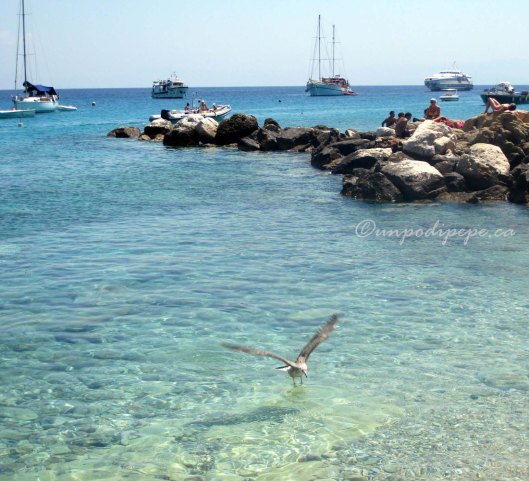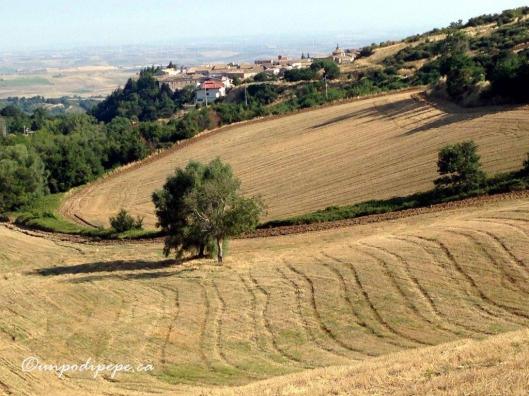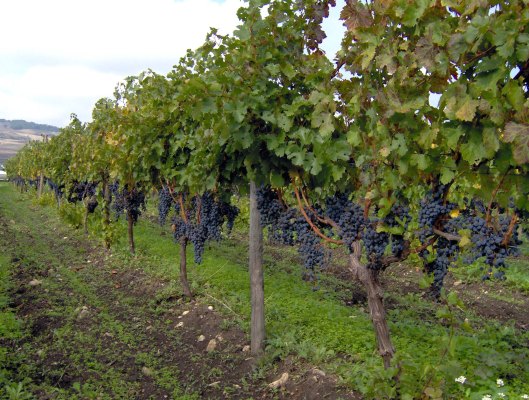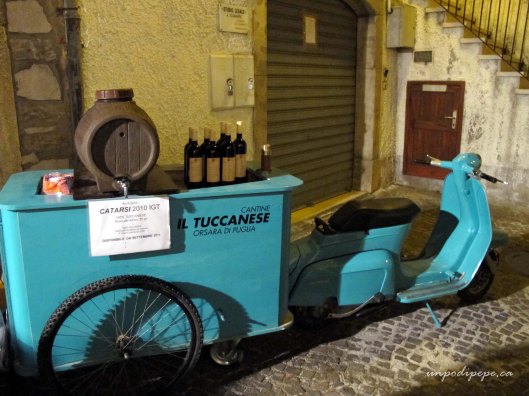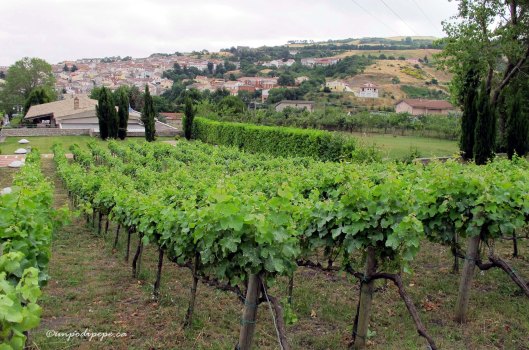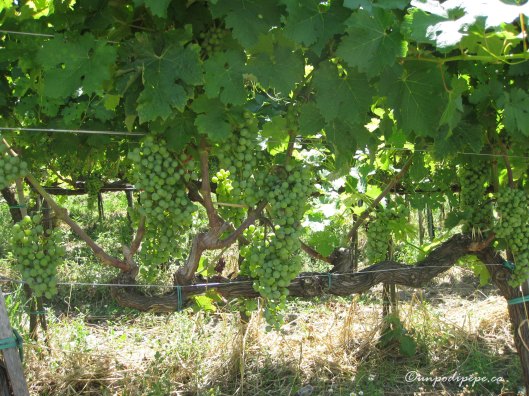Tags
Cinque Terre card, Corniglia, Corzetti, Liguria, Manarola, Monterosso a mare, Pesto Genovese, UNESCO World Heritage Sites, Vernazza
 Le Cinque Terre are 5 stunning clifftop villages on the Coast of Liguria, between La Spezia and Levanto. In my last post I described the area, the villages, how to get there and around. In this post, I write specifically about the experiences I had visiting the area 6 weeks ago with my nipotina* Isabella. Hiking between the 5 villages was our plan. They are connected by rail and also by a series of ancient donkey trails. Along the sea is the ‘Sentiero Azzurro (blue trail) which is flat between Riomaggiore and Manarola, but otherwise gains quite a bit of elevation. The other series of trails is the Sentiero Rosso (red trail), higher up into and over the mountains and terraced vineyards. These are longer and much more challenging, and include trails going to 5 Sanctuaries-one above each village.
Le Cinque Terre are 5 stunning clifftop villages on the Coast of Liguria, between La Spezia and Levanto. In my last post I described the area, the villages, how to get there and around. In this post, I write specifically about the experiences I had visiting the area 6 weeks ago with my nipotina* Isabella. Hiking between the 5 villages was our plan. They are connected by rail and also by a series of ancient donkey trails. Along the sea is the ‘Sentiero Azzurro (blue trail) which is flat between Riomaggiore and Manarola, but otherwise gains quite a bit of elevation. The other series of trails is the Sentiero Rosso (red trail), higher up into and over the mountains and terraced vineyards. These are longer and much more challenging, and include trails going to 5 Sanctuaries-one above each village.
Rain and mudslides periodically damage the trails. It is important to check the conditions on the Cinque Terre website. 2 of the 4 sections of Sentiero Azzurro have been closed for a while and are apparently not scheduled to reopen until 2021! We knew this before arriving, but did not know that the trail from Corniglia to Vernazza was also recently closed!
At the Cinque Terre Info Point in La Spezia buying Cinque Terre cards, we were informed of the extra closure. This left us with only 1 accessible section, the Vernazza to Monterosso al Mare section-the most strenuous, of course. To make things worse, they would not sell us a 2 day Cinque Terre card. Perché? Because the next day was going to be one of those dreaded ‘sciopero dei treni’– train strike. Mannaggia! These unexpected things happen when travelling, and no amount of planning ahead will prevent them-so we just adjusted our plans and made the best of it.
 Our accomodation was in Vernazza, so we headed there first. Getting off the train at noon, my first thought was ‘mannaggia a te Rick Steeves!’ Via Roma, the main street of this beautiful but tiny village was so packed with people we barely had elbow room! It was loud, crowded, and probably the worst time of day to be there. I could hear the waiters approach everyone in english-a pet peeve of mine. This was mid-May-I can only imagine summer!
Our accomodation was in Vernazza, so we headed there first. Getting off the train at noon, my first thought was ‘mannaggia a te Rick Steeves!’ Via Roma, the main street of this beautiful but tiny village was so packed with people we barely had elbow room! It was loud, crowded, and probably the worst time of day to be there. I could hear the waiters approach everyone in english-a pet peeve of mine. This was mid-May-I can only imagine summer!
 After pushing our way down Via Roma to Piazza Marconi at the harbour, we checked in at the restaurant renting our room. The room was waaaaay up a series of 6 narrow staircases winding through tiny streets and alleys, just below Castello Doria. I was glad I did not have a lot of luggage! The view from the top was worth the climb! The roof had a terrazza with chairs and a view of the sea. I could have sat there with a book, but since there were no trains the next day, it was time to do some exploring.
After pushing our way down Via Roma to Piazza Marconi at the harbour, we checked in at the restaurant renting our room. The room was waaaaay up a series of 6 narrow staircases winding through tiny streets and alleys, just below Castello Doria. I was glad I did not have a lot of luggage! The view from the top was worth the climb! The roof had a terrazza with chairs and a view of the sea. I could have sat there with a book, but since there were no trains the next day, it was time to do some exploring.
 To get to Corniglia, we took the train and climbed the almost 400 steps up from the stazione. Cute and quieter, Corniglia is the only village not on the sea.
To get to Corniglia, we took the train and climbed the almost 400 steps up from the stazione. Cute and quieter, Corniglia is the only village not on the sea.  I looked around for a Corzetti stamp with no luck, then we set off on the much longer and steeper Sentiero Rosso to Manarola via an inland town called Volastra.
I looked around for a Corzetti stamp with no luck, then we set off on the much longer and steeper Sentiero Rosso to Manarola via an inland town called Volastra.  There were viste mozzafiate-breathtaking views in every direction and the trail not crowded at all. It took us right through ‘vertical farmland’ high above the sea. They are called terrazzamenti a fasce -strip terraced vineyards and olive groves. I thought these long metal poles and brackets were to give support against rock and mudslides, but the next day I found out what they were for.
There were viste mozzafiate-breathtaking views in every direction and the trail not crowded at all. It took us right through ‘vertical farmland’ high above the sea. They are called terrazzamenti a fasce -strip terraced vineyards and olive groves. I thought these long metal poles and brackets were to give support against rock and mudslides, but the next day I found out what they were for.
It took almost 3 hours to reach Manarola, a lovely town with a cute harbour and several viewpoints to walk to and watch the sunset.  We decided not to go to Riomaggiore, as trains are less frequent in the evening and our visits to both towns would have been too rushed. Arriving by train back to Vernazza, the daytrippers were long gone and it was a beautiful evening for walking along the tiny harbour, taking photos and watching people try to fish.
We decided not to go to Riomaggiore, as trains are less frequent in the evening and our visits to both towns would have been too rushed. Arriving by train back to Vernazza, the daytrippers were long gone and it was a beautiful evening for walking along the tiny harbour, taking photos and watching people try to fish.
The next morning, after colazione-breakfast on another terrazza overlooking the sea, we climbed up to Castello Doria, a few flights of stairs above our room. We had 360° views over Vernazza, the mountains and the sea.  Then we headed out of town on the Sentiero Azzurro to Monterosso a Mare before the onslaught of daytrippers stepped off the train. The trail started just above Vernazza.
Then we headed out of town on the Sentiero Azzurro to Monterosso a Mare before the onslaught of daytrippers stepped off the train. The trail started just above Vernazza.  It was a steep uphill climb for awhile and then we were rewarded with birds’ eye views directly over Vernazza.
It was a steep uphill climb for awhile and then we were rewarded with birds’ eye views directly over Vernazza. 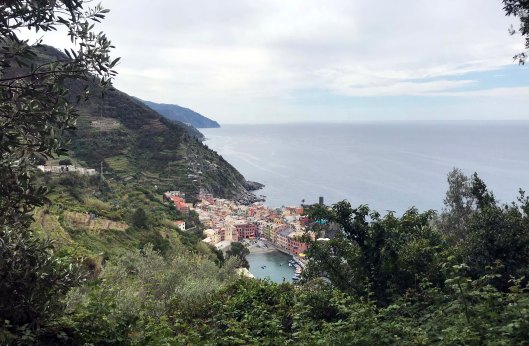 There were many more hikers on this trail than on the one yesterday, but it was not overly crowded. I did say ‘Buongiorno’ a lot! The scenery was amazing and included walks through more terraced vineyards, olive and lemon groves.
There were many more hikers on this trail than on the one yesterday, but it was not overly crowded. I did say ‘Buongiorno’ a lot! The scenery was amazing and included walks through more terraced vineyards, olive and lemon groves.  I even had a closer look at some of the mysterious looking machinery and contraptions for transporting grapes down the mountain that I had seen the day before.
I even had a closer look at some of the mysterious looking machinery and contraptions for transporting grapes down the mountain that I had seen the day before.
 Monterosso was visible long before we reached it. The beach was long and sandy with a lungomare, a seaside walkway. We spotted fritto misto da asporto-takeout mixed fried seafood and veggies sold in paper cones. Despite the sciopero, a few local trains went by. We thought about taking the train to Riomaggiore, but were concerned about getting stuck there without a train back. We returned to Vernazza and bought pesto focaccia and a paper cone of fritto misto to have on the terrazza.
Monterosso was visible long before we reached it. The beach was long and sandy with a lungomare, a seaside walkway. We spotted fritto misto da asporto-takeout mixed fried seafood and veggies sold in paper cones. Despite the sciopero, a few local trains went by. We thought about taking the train to Riomaggiore, but were concerned about getting stuck there without a train back. We returned to Vernazza and bought pesto focaccia and a paper cone of fritto misto to have on the terrazza.
I was excited to finally find my stampo per Corzetti! Corzetti (Croxetti in Genovese) are traditional Ligurian pasta shaped like large coins with a design stamped on both sides. The design holds the sauce better! It was hand carved by a local fisherman and I can’t wait to try it. One design is an ear of wheat and the other a ‘swirly thing’. I looked for one in every town, and ended up finding it right in Vernazza. The shop owner and Isabella could not believe how excited I was to find it! Stay tuned for a corzetti pasta post in the future.
Later we walked part of the Vernazza to Corniglia trail, turning back at the point where it was closed. The views of Vernazza from the other side were amazing, but the weather was starting to change.  The Sentiero Rosso can get to Corniglia, via the Sanctuary of San Bernardino, but it takes 3.5 hours! In the evening I attended a Cinque Terre wine tasting event hosted by Alessandro, a local sommelier on the terrazza. I tasted 3 Cinque Terre whites while looking out at the sea. Hiking with a 19 year old is exhausting, so this was a perfect way to end the day! Salute!
The Sentiero Rosso can get to Corniglia, via the Sanctuary of San Bernardino, but it takes 3.5 hours! In the evening I attended a Cinque Terre wine tasting event hosted by Alessandro, a local sommelier on the terrazza. I tasted 3 Cinque Terre whites while looking out at the sea. Hiking with a 19 year old is exhausting, so this was a perfect way to end the day! Salute!
We loved our 2 days/nights in le Cinque Terre and could have used another day to go to Riomaggiore, and possibly take a boat. In our case, it is better we did not stay an extra day though-as we left for Milano in a torrential downpour. In bad weather, there are no indoor activities in the Cinque Terre villages-except reading a book on a terrazza. Travel to the area is best between April and September. October and November are rainy, then it gets cold.
 In case you think that in my photos it does not look crowded, this is because I could not move my elbows wide enough to take a photo during the peak times! Le Cinque Terre are no longer an undiscovered gem but are definitely still worth visiting. If planning a visit, I would definitely recommend staying in one of the villages, for a calmer experience and to enjoy the mornings and evenings when the crowds of daytrippers have left for the day. During the busy hours, go hiking and exploring. The best way to see the area is on the trails! Many visitors stay in Portovenere or La Spezia for cheaper accomodation, but I do not think the experience is the same at all. Day tours also arrive from Firenze and Milano, 2.5-3 hours away, leaving little time to see the area. Be a daytripper only if you have no other option to ever visit the area. Staying in one of the villages may not be advisable for those with mobility issues or a lot of luggage.
In case you think that in my photos it does not look crowded, this is because I could not move my elbows wide enough to take a photo during the peak times! Le Cinque Terre are no longer an undiscovered gem but are definitely still worth visiting. If planning a visit, I would definitely recommend staying in one of the villages, for a calmer experience and to enjoy the mornings and evenings when the crowds of daytrippers have left for the day. During the busy hours, go hiking and exploring. The best way to see the area is on the trails! Many visitors stay in Portovenere or La Spezia for cheaper accomodation, but I do not think the experience is the same at all. Day tours also arrive from Firenze and Milano, 2.5-3 hours away, leaving little time to see the area. Be a daytripper only if you have no other option to ever visit the area. Staying in one of the villages may not be advisable for those with mobility issues or a lot of luggage.
Individual train tickets between La Spezia and Levanto are €4 and valid for 75 minutes. If you plan to hike and take the train, buy a Cinque Terre Card. The combo card (trekking and treno) includes unlimited train travel between La Spezia and Levanto, use of all the trails, and wifi that actually works! It costs €16 per day. For trekking only, it is €7.50 per day. The card is available for 2 and 3 days- except in the case of un sciopero! There are also family and low season prices. For more information, check here. Open toed shoes and smooth soles are not allowed on trails.
Eat as much seafood as possible, and pesto, not necessarily together-although Fooderia Manarola (@fooderia_manarola on instagram) does have panino con polpo (octopus) e pesto! My pesto is very good (recipe here) but the besto pesto is in Liguria! You can choose traditional trofie con pesto, lasagne con pesto and pesto focaccia. Pesto heaven! The paper cones of fritto misto -assorted seafood and veggies are delicious takeout food.
Have you visited le Cinque Terre? What did you think? Buon viaggio, Cristina
*Nipote or nipotina means both niece and granddaughter. In this case, it means niece!




























